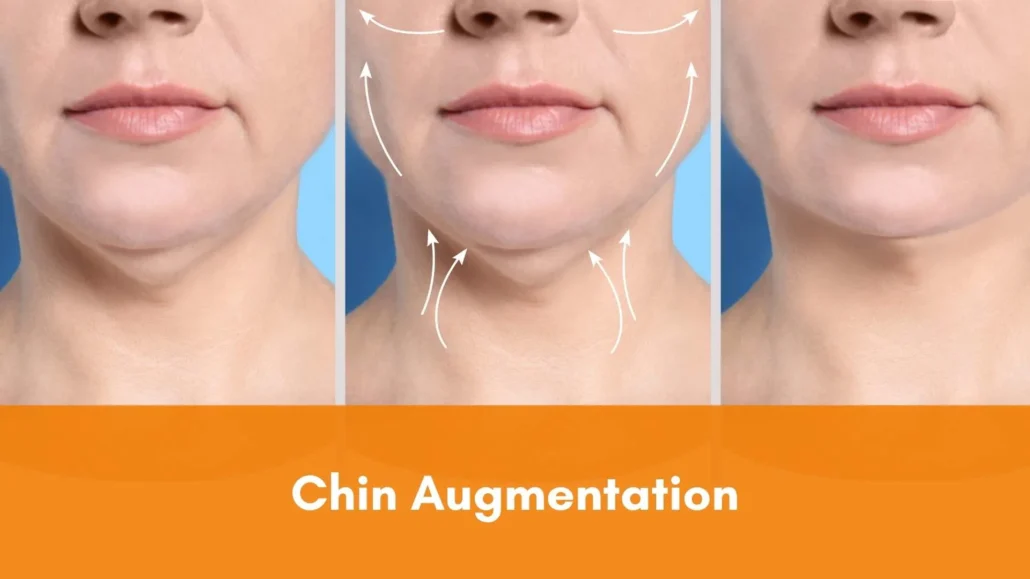Chin Augmentation: Benefits, Cost & Considerations

Chin augmentation, let’s start with that phrase itself. It’s not just a clinical term, it’s really about how your face looks in balance… how one feature supports the other. A strong, defined chin can completely change the way someone sees your profile, or even how your jawline feels when you look in the mirror.
At its core, chin augmentation is a cosmetic procedure. The goal is simple, to enhance the projection of the chin. This might be done with a chin implant, which is a surgical option, or with non-surgical chin augmentation using fillers. Both aim for the same thing: better harmony in the lower half of your face.
This guide to chin augmentation will take you through every step… from what it really is, to the different options, why people go for it, and what recovery feels like. Think of it as a comprehensive guide, where you’ll get the big picture but also those small details that help you decide if you’re considering chin augmentation for yourself.
Table of Contents
What is Chin Augmentation?
So, what exactly is chin augmentation? Essentially, it’s facial plastic surgery, a form of cosmetic surgery addressing structure and proportion. It’s a surgical treatment intended to improve a chin that’s too small, too feeble, or misshapen in relation to the face.
If the person has a receding or thin chin, also sometimes called receding chin, the lower face could appear less defined. Even an underprojected chin can give a double chin illusion to an otherwise fit and healthy individual. That’s where chin augmentation comes in, offering a solution to redefine and increase projection.
It’s not only implants. There are surgical options like genioplasty, where the chin bone itself is repositioned, and chin implant surgery where a silicone implant is placed over the bone. Both are considered effective. The end goal is always the same, balance and a stronger sense of proportion in your face.
Types of Chin Augmentation
When you start looking into it, you’ll see there are really two main types of chin augmentation.
Surgical Chin Augmentation
This is the more conventional approach, wherein a plastic surgeon inserts an implant. These implants are typically manufactured from safe materials such as silicone, and they rest either through a cut inside the mouth or underneath the chin. The implant is inserted above the current chin bone, making it appear more prominent.
The operation may sound daunting, but the methods are well proven. A trained surgeon can produce a very natural appearance, one which blends with your jawline. The important thing in this case is that surgery generally provides a permanent solution, a change that will last.
Non-surgical Chin Augmentation
The second alternative is less invasive. Non-surgical chin augmentation uses injectable fillers. A dermal filler is injected directly into the chin, contouring the chin and providing projection without surgery.
This is a good choice for individuals who don’t like downtime, or who just want to experiment with an adjustment before undergoing surgery. Fillers can provide definition and harmony, but this is just temporary, lasting anywhere from a year to two years.
If you weigh these chin augmentation methods against each other, surgery provides longevity, while fillers offer versatility. Both are good chin augmentation methods depending on whether or not you like what you want.
Why People Consider Chin Augmentation
If you’ve ever looked in the mirror and felt your chin just doesn’t match the rest of your face, you’re not alone. Many people consider chin augmentation for specific concerns.
A weak chin, sometimes described as a receding or recessed chin, is one of the most common reasons. Others might feel their chin is underdeveloped, too small in proportion to their features. Some notice a double chin that isn’t about weight, but rather about lack of definition in the lower face.
Chin augmentation can address all of these. By enhancing the chin, the procedure brings it into proportion with the nose, lips, and jawline. It’s not about making your chin look bigger in isolation, it’s about facial structure and balance.
If you’re considering chin augmentation, it often comes from this very point, wanting a chin that supports your overall look rather than distracts from it.
Benefits of Chin Augmentation
So, what are the advantages of chin augmentation? Let’s list them clearly.
- A well-defined chin, which helps the chin and jawline work together in harmony.
- Improved overall facial structure, balance between features.
- Long-term chin enhancement results, especially with implants.
- The ability to reshape the size of the chin and enhance chin projection in a way that looks natural.
But here’s the thing. The benefits of chin procedures go beyond appearance. They often touch on confidence. Many people report feeling more comfortable in photographs, more at ease in social settings, even more assertive at work. The external change can shift the way you carry yourself internally.
The Chin Augmentation Procedure Explained
Let’s break down what actually happens during a chin augmentation procedure.
If surgery is your option, a board-qualified plastic surgeon will make an incision, either below the chin or inside the mouth. The implant, most often silicone, is then properly placed over the chin bone. When genioplasty is performed, the bone is actually cut and relocated and secured in position. Both are exact surgical procedures.
If you opt for the non-surgical route, fillers are injected into the chin. The process is normally swift, very little pain, and no cuts.
Safety is the key. You must have a board-certified plastic surgeon, whoever you are seeing, with experience. This way, chin augmentation methods are properly used, minimizing risk and optimizing results.
Therefore, ch in augmentation procedure choices amount to implants or fillers, surgical or non-surgical, based on your comfort level and needs.
Recovery & Results of Chin Augmentation
Recovery looks a little different depending on which type of chin augmentation you choose.
With surgery, you’ll need some downtime. Bleeding and swelling are common, but they will resolve after a couple of weeks. The majority of individuals can get back to work within 7–10 days. The final outcome is apparent as the swelling resolves within a few months.
Recovery with fillers is significantly less. There may be some swelling or redness for a couple of days, but otherwise, you can go back to normal right away.
Effects of chin surgery are generally long-term, particularly with implants. Fillers are temporary and therefore need to be maintained if you want to retain the appearance.
Another point worth mentioning, chin augmentation with other procedures is very common. Some people combine it with rhinoplasty, or even jawline contouring, to enhance the balance of the entire face.
Cost of Chin Augmentation
Now, let’s talk about the cost of chin augmentation. It can vary a lot.
The kind of chin augmentation you opt for makes a great difference. Surgical options are pricier since they require anaesthesia, operating room charges, and implant price. Non-surgical chin augmentation using fillers is usually less expensive, but mind you, it requires repeat injections.
Surgeon skill is also relevant. An extremely skilled board-certified plastic surgeon can cost more, but this typically goes hand-in-hand with improved results and fewer complications. Location is also relevant, with rates in large cities typically higher.
The cost of chin procedures will vary across plastic surgery clinics. For more details, learn more about the cost and options of chin augmentation on our service page.
Conclusion
So how do you go about choosing the right chin augmentation for yourself?
It all depends on what you want. If you are looking for a long-lasting change and do not mind having surgery, a chin implant can be the route you take. If you want to have the option of modifying it down the road, or merely would like to experiment with having a sculpted chin, non-surgical chin augmentation is a good place to start.
If you’ve ever considered having a more sculpted chin, this could be the solution. And if you’re thinking about chin augmentation, keep this in mind, folks: talk to a board-certified plastic surgeon to discuss the safest and most effective approaches.
FAQs
What is the difference between chin fillers and chin implants?
Chin fillers are non-surgical and use dermal fillers to temporarily enhance chin projection (lasting 12–18 months). Chin implants are a surgical solution, reshaping the bone for permanent results and a more defined jawline.
How much does chin augmentation cost in India?
Chin augmentation typically costs ₹80,000–₹1,50,000 in India. The price varies depending on the surgeon’s expertise, location, and whether fillers or implants are used.
What is the recovery time after chin augmentation?
Most patients recover within 5–7 days, with swelling and bruising improving in 2–3 weeks. Final results are usually visible after 6–8 weeks.
Is chin augmentation painful?
Pain is usually mild and manageable with medication. Some tightness, swelling, and discomfort are common in the first few days but improve quickly.
Will chin augmentation leave visible scars?
Scarring is minimal or hidden. Surgeons often place incisions inside the mouth or under the chin to keep them discreet.
Are chin augmentation results permanent?
Yes — chin implants provide permanent results. Filler-based chin augmentation lasts about 12–18 months and requires repeat sessions.
What are the risks and complications of chin augmentation?
Possible risks include swelling, infection, implant shifting, or temporary numbness. Choosing a qualified plastic surgeon helps minimize complications.
View More Services


